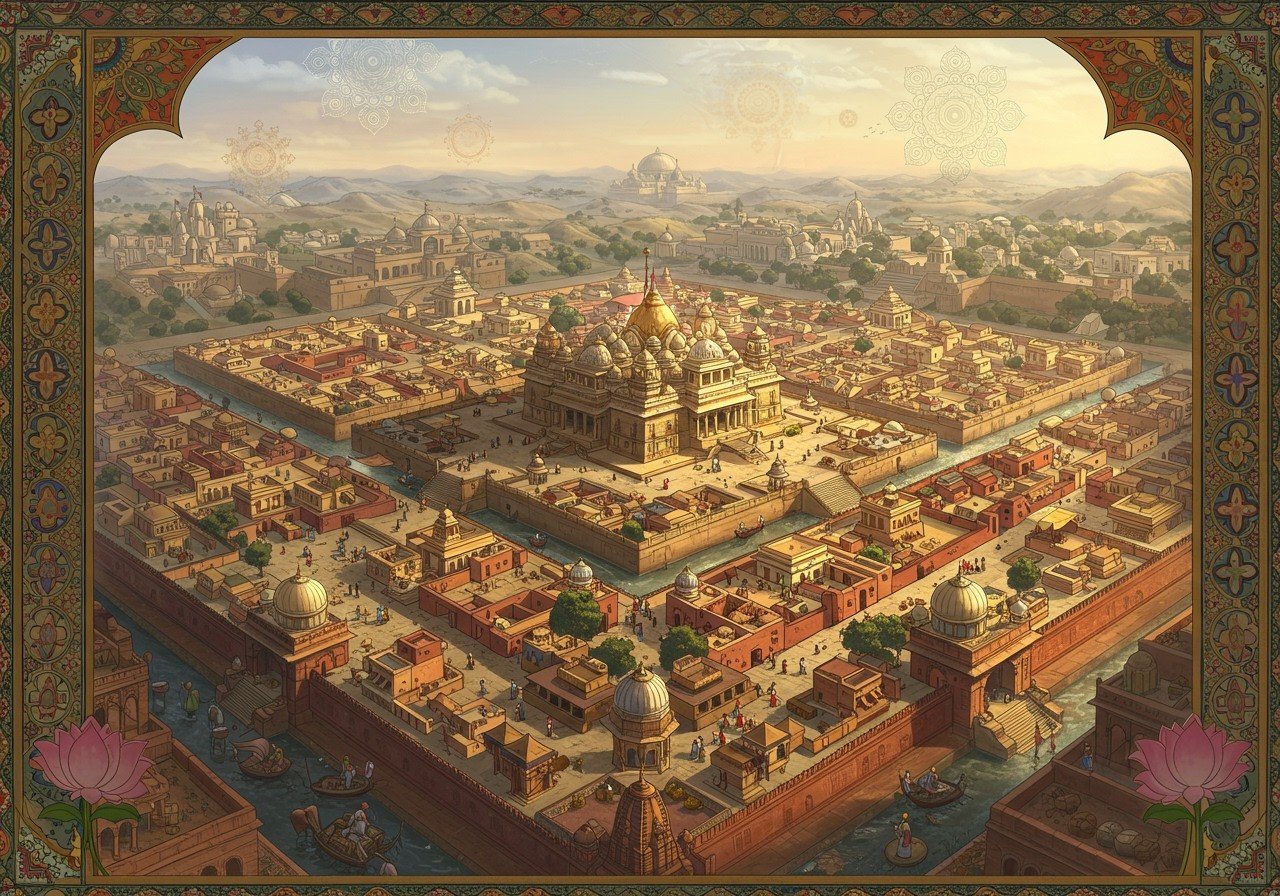
Ancient Indian cities stand as testaments to sophisticated urban planning and architectural ingenuity. These cities, especially those of the Indus Valley Civilization, showcase meticulous design, advanced infrastructure, and remarkable social organization. This exploration delves into the intricacies of ancient Indian city planning, highlighting examples like Lothal, and comparing them with other ancient Indian urban landscapes. Understanding these practices offers a glimpse into the cultural and technological advancements of the era.
Town Planning in the Indus Valley Civilization (c. 2500 BCE)
The Indus Valley Civilization, flourishing around 2500 BCE, exhibits remarkable urban planning. Key characteristics include:
- Grid Layout: Cities followed a grid pattern, with streets intersecting at right angles, promoting efficient movement and organization. This structured layout facilitated easy navigation and a sense of order within the city.
- Advanced Drainage Systems: The civilization boasted elaborate drainage systems, featuring covered drains along main streets and individual house drains, prioritizing hygiene and sanitation. This sophisticated system ensured the efficient removal of wastewater and contributed to a healthier urban environment.
- Standardized Brick Sizes: The consistent use of standardized bricks in construction signifies advanced planning and architectural uniformity. This standardization allowed for efficient construction and contributed to the aesthetic harmony of the cities.
- Public and Private Spaces: Designated areas for public structures like granaries and baths existed separately from private residential quarters, demonstrating a clear understanding of urban zoning. This separation of spaces contributed to the functionality and organization of the cities.
- Water Management: The presence of wells, reservoirs, and sophisticated water systems for domestic and agricultural use reveals advanced water management techniques. These systems ensured a reliable water supply for various needs within the city and its surrounding areas.
- Fortifications: Cities like Harappa and Mohenjo-Daro possessed fortified sections, indicating organized defense mechanisms and a focus on security. These fortifications protected the cities from external threats and provided a sense of safety to the inhabitants.
- Social Organization: The city layouts reflect a structured social hierarchy, with planned sectors for artisans, merchants, and the ruling elite. This organization suggests a well-defined social structure and division of labor within the civilization.
Lothal’s Unique Town Planning (c. 2400 BCE)
Lothal, a significant Indus Valley city, stands out for its advanced maritime infrastructure:
- Dockyard: Lothal’s dockyard, possibly the world’s oldest, highlights the city’s crucial role in maritime trade and activity. Its sophisticated design and strategic location facilitated trade and communication with other regions.
- Warehouse: The strategic placement of warehouses near the dockyard facilitated efficient storage and management of goods, further emphasizing Lothal’s commercial importance. This arrangement streamlined trade operations and ensured the smooth flow of goods within the city.
- Residential Areas: Organized residential areas with consistent house sizes and layouts suggest a planned and egalitarian approach to housing. This uniformity reflects a degree of social organization and planning within the city’s residential areas.
- Street Layout: Lothal’s grid-patterned streets, with well-defined lanes and thoroughfares, mirrored the organized structure of other Indus cities. This structured layout facilitated easy navigation and efficient movement within the city.
- Drainage System: Lothal’s sophisticated drainage system, similar to other Indus cities, ensured effective waste management and sanitation. This advanced system contributed to the overall hygiene and health of the urban environment.
- Craftsmanship: Evidence of advanced craftsmanship, including bead-making workshops and pottery production, reveals Lothal’s thriving artistic and manufacturing activities. These specialized workshops indicate a high level of skill and artistic development within the city.
- Trade Networks: Archaeological findings reveal Lothal’s extensive trade connections with other regions, highlighting its importance as a commercial hub. These trade networks facilitated the exchange of goods and ideas, contributing to the city’s economic and cultural growth.
Comparing Lothal and Other Ancient Indian Cities
While Lothal showcases maritime-focused planning, other ancient cities demonstrate diverse urban principles:
- Harappa and Mohenjo-Daro (c. 2500 BCE): Both featured grid layouts and drainage, but differed in scale and public spaces. Mohenjo-Daro’s “Great Bath” stands out as a unique public structure.
- Dholavira (c. 2650 BCE): Known for its exceptional water conservation systems, including stepwells and large reservoirs, demonstrating advanced water management practices.
- Kalibangan (c. 2900 BCE): Distinguished by fire altars and early agricultural practices, highlighting the city’s ritualistic and agrarian aspects. Ancient Indian city planning and architecture featured Chaturmukha structures, which symbolized the four cardinal directions and provided protection and access.
- Rakhigarhi (c. 2600 BCE): The largest Indus Valley site, its complex layout indicates advanced urban planning and a substantial population.
- Varanasi (c. 1800 BCE): One of the oldest continuously inhabited cities, demonstrating enduring religious and cultural significance throughout history.
- Pataliputra (c. 490 BCE): A historical capital of ancient India, known for its strategic location and administrative planning. Sacred and ancient Indian texts detailed Vedic city planning to ensure community well-being and prosperity, often using rectangular or square layouts. Evidence of town planning conventions dates back to around 2500 BCE, with cities like Kalabangan displaying remarkable mathematical symmetry in their street and lane widths.
- Ujjain (c. 600 BCE): An ancient city renowned for its astronomical significance and traditional urban design.
Poojn.in: Connecting You with India’s Rich Heritage
Poojn.in, India’s leading online store for cultural and religious goods, offers a wide array of products that connect you with India’s rich heritage. Explore our collection of:
- Shiva Lingams: Honor Lord Shiva with beautifully crafted lingams.
- Tulsi Malas: Embrace the sacred Tulsi plant with traditional prayer beads.
- Pooja Asans: Create a sacred space for your rituals with our comfortable asans.
Visit Poojn.in today to discover more and enrich your spiritual journey!
Conclusion
Ancient Indian cities offer invaluable lessons in sustainable practices, social organization, and urban development. Their sophisticated planning and advanced infrastructure demonstrate the ingenuity and foresight of our ancestors. By studying these ancient cities, we gain a deeper understanding of our rich heritage and can draw inspiration for building sustainable and thriving urban environments in the future.


